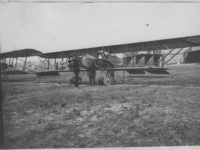The Caudron G.IV was a French bomber that was used by the French Air Force on the Western Front from late autumn 1915.
Development and construction:
In order to be able to cover the growing demand for bombers for the French air force, the company Société des aeroplanes Caudron began at the beginning of 1915 with the further development of the Caudron G.III, which was already in use. The focus was particularly on a good climb performance and range in order to be able to use this aircraft as a bomber.
As with the Caudron G.III, the pilot and the observer sat one behind the other in a rather short fuselage gondola. The biggest change, however, was that the G.IV used two motors instead of one, which were installed next to the nacelle. As a result, the range and the overall performance could be increased significantly. In addition, the arrangement of the engines improved the observer's field of vision to the front.
The armament was also improved with a second machine gun, but the disadvantage of the side motors was the limited field of fire to the front and rear. This disadvantage was attempted during the war by the fact that the bombers flew in a tightly closed formation and were able to give each other cover.
The first flight of the prototype took place in March 1915. The French Air Force was convinced by the performance of the aircraft, so that in mid-1915 an order for a larger number of aircraft was received and production could start.
Use in the First World War:
At the end of 1915, the first Caudron G.IV bombers were delivered to the French squadrons and used on the Western Front. A total of 38 squadrons had this type of aircraft, which, despite the low bomb load, was used for distant bombings such as the German Zeppelin halls in Belgium or industrial sites on the Rhine.
In the course of 1916, however, work began on withdrawing the first Caudron G.IV bombers from the front and replacing them with the better Caudron G.VI aircraft. Since the losses of bombers of this type were temporarily very high, the last bombers remaining on the front were mostly used for attacks at night.
A total of 1.421 aircraft were produced, with bombers again being built by licensees in Great Britain and Italy. Through the sale of the aircraft, countries such as Romania, Belgium, Russia or Finland also received some bombers of this type, some of which were still used in these countries until the end of the war.
In addition to the bomber variant, a few types of reconnaissance aircraft under the designation Caudron G.IVA.2 and attack aircraft G.4IB were also produced.
Until the end of the war, some of the aircraft that had been withdrawn from the front were still used as training aircraft under the designation G.IVE.2.
Technical specifications:
| Designation: | Caudron G.IV |
| Country: | France |
| Type: | Bomber |
| length: | 7,20 meters |
| Span: | 17,20 meters |
| Height: | 2,60 meters |
| Weight: | 760 kilograms empty |
| Crew: | Max. 2 |
| Engine: | two air-cooled rotary motors Gnôme-Rhône or Anzani with 80 to 100HP |
| Maximum speed: | 132 kilometers per hour |
| Range: | Max. 3,5 hours of flight |
| Armament: | 1-2 machine guns 7,7 mm 100 kilograms bomb load |
This post is also available in:
 Deutsch (German)
Deutsch (German)  Français (French)
Français (French)  Italiano (Italian)
Italiano (Italian)  简体中文 (Chinese (Simplified))
简体中文 (Chinese (Simplified))  Русский (Russian)
Русский (Russian)  Español (Spanish)
Español (Spanish)  العربية (Arabic)
العربية (Arabic)

















